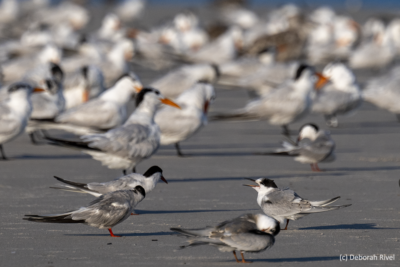
What happens when we flush a resting flock of birds? During nesting season most people make an effort to not disturb birds nesting in trees, or on the ground or beach, as the consequences are obvious. But what about a flock just hanging out? How can chasing them, walking too close or having a dog on the beach cause problems? It doesn’t take a lot of effort to walk around resting flocks of birds, and here’s why it’s important to do this.
Shorebirds on the beach in late summer and fall are often in the middle of a long and arduous migration. The birds dont look like they are doing much as they are often sleeping or loafing. But that’s the point of a stopover. Many of the resting birds have flown a great distance and rely on a safe resting spot to gain the energy to complete their migration. Disturbing these flocks may cause the birds to use the energy they are trying to conserve for their migration to flee from this intrusion.
Shorebirds are known for their extreme migration – some flying nearly pole to pole roundtrip each year – 18-20,000 miles. Many of these birds form pre-migratory flocks – ranging from a dozen to several thousand birds – which include young ones born earlier in the summer, who are still getting their strength together to fly a long distance. Learning to catch fish by diving is a tricky skill, and some of the birds in these flocks, like Royal and Common Terns are still feeding their young ones (like the begging juvenile above) as Junior is still practicing the fine art of fishing before taking off southward. Flushing a flock like this uses up energy they are trying to gain and conserve for the flight south, and separates parents from the little ones – who dont look so little, but still need to be fed by mom; and forces birds who might not be capable of strong flight to escape over open water.
For more information check out this article from the Florida Fish and Wildlife Conservation Commission.